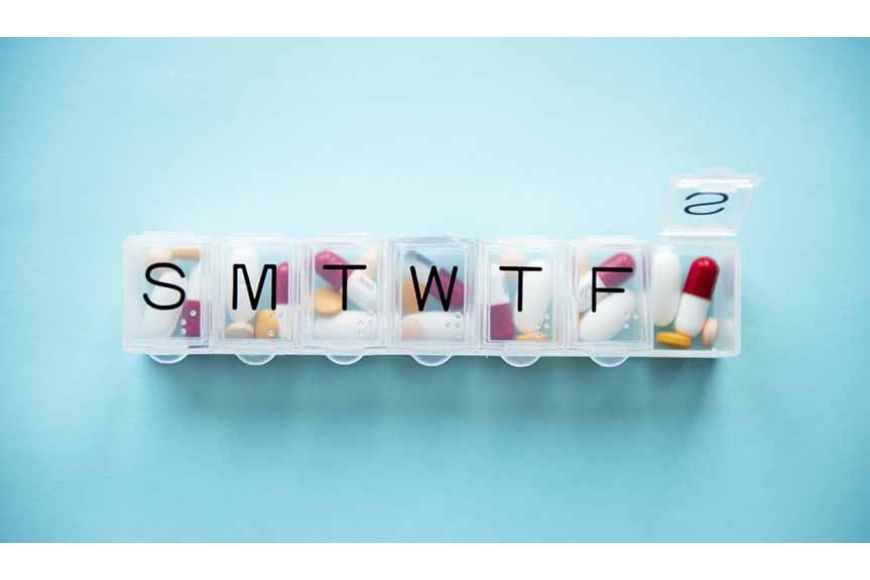7 Tips for Managing Multiple Medications

Advances in medicine and pharmaceuticals help medical professionals prevent, eliminate, and treat a wide range of health conditions. Depending on symptoms or condition(s), patients may need to take multiple medications. In fact, the CDC reports 24% of Americans regularly use three or more prescription drugs.1 Complex combinations of drugs may be medically necessary to help patients treat their existing conditions. However, managing multiple medications can be difficult for patients. In this article, we’ll provide tips to help patients or caregivers keep track of medications and take as directed.
1. Review Your Medication with Your Doctor
If you or someone who you provide care for is taking multiple medications, it’s important to regularly communicate with a family physician. Discuss all of the medications that you take, and be sure to ask about possible side effects and interactions of any newly prescribed drugs. Your pharmacist is another professional that you can look to for guidance. Communicate with them regularly and ask your pharmacist any questions that you have about your medications. It’s also important to inform your doctor and pharmacist of any additional supplements or over-the-counter medications that you are taking, including nutritional supplements like multivitamins and herbal supplements.
2. Read Medication Labels
Medication labels provide patients with important information about their prescriptions. Be sure to thoroughly read Rx labels to understand the proper dosage and instructions for each medication that you are taking. Certain medications may require you to take them at a certain time, with a meal, or on an empty stomach. Knowing how and when to take each drug will help you create a detailed medication management plan and routine. Drug labels also include important information for interactions, side effects, and potential warnings. Similar to prescription drugs, also read the labels of any over-the-counter medications that you take, as well. OTC medications can interact with Rx drugs.
3. Learn About Possible Drug Interactions
When talking with your doctor about current or newly prescribed medications, always ask about drug interactions. You may be at a higher risk for drug interactions if you take more than one medication.2 Interactions can occur between different Rx medications, but also a drug any other substances like food or supplements. Always read drug labels and talk with your doctor or pharmacist about all prescription and non-prescription drugs that you take, including vitamins and herbal supplements.
4. Use a Pill Box
A pill box or case is a simple way to ensure that you are taking all of your medications on time. Simple pill boxes have separate compartments for each day. For patients who take medications at different times of the day, purchase a pill case that includes compartments for morning, afternoon, and night for each day of the week. Alongside your pill box, keep a chart that clearly outlines your daily medication schedule. Use this chart to ensure you have adhered to your schedule as you fill your pill box each week.
5. Keep a Detailed List of Your Medications
It’s important to keep a list of all the medications you take, both prescription and non-prescription. Include the name of the drug, the dose, how often you take it, and what the drug was prescribed to treat. Be sure to update this list regularly and to have multiple copies. Keep one copy at home with any other medical files, carry a copy with you for appointments or trips to the pharmacy, and provide a copy to a family member or caregiver in case of an emergency.
6. Stick with a Single Pharmacy
Try to fill your prescriptions at one pharmacy and stay with that pharmacy whenever possible. Every pharmacy maintains records of the prescriptions that they fill, and most are unable to access or view records from other pharmacies. Using the same pharmacy provides the pharmacist with a complete list of all of the medications that you are taking. This helps prevent drug interactions and also makes filling your prescriptions simpler. Together, this can be helpful when managing multiple medications.
7. Use a Medication Management App or Device
There are a number of helpful medication management apps or devices available. These include devices like alarmed medication reminders. There are also many apps available for smartphones and tablets. These apps allow users to input their medication and set reminders to take their medication, as well as refill their prescriptions.
Find Rx Discounts with America’s Pharmacy
While taking multiple medications is common and necessary for many people, it can also be expensive. America’s Pharmacy can help you find prescription discounts and save.
Search and compare prices for your prescriptions with our Rx price comparison tool. After you’ve found the best price on your medications, simply show your coupon or America’s Pharmacy discount card to the pharmacist. They’ll take care of the rest.
Don’t have an America’s Pharmacy card? No problem! It’s fast, easy, and completely free. Have your card sent to you digitally or receive a physical card in the mail. You can even download our free mobile app! Start saving with America’s Pharmacy!
Sources:
1. https://www.cdc.gov/nchs/fastats/drug-use-therapeutic.htm
2. https://medlineplus.gov/ency/patientinstructions/000883.htm
